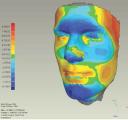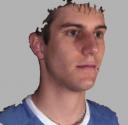 Originally a system for merging range data from 3D Scanners. I modified this software and hijacked its ICP algorithms for use in a 3D face recognition system. An excellent bit of software with a highly customisable interface and a powerful scripting language.
Originally a system for merging range data from 3D Scanners. I modified this software and hijacked its ICP algorithms for use in a 3D face recognition system. An excellent bit of software with a highly customisable interface and a powerful scripting language.
Scanalyze
OpenCV
An excellent and fully featured computer vision library. OpenCV (Open Source Computer Vision) is a library of programming functions mainly aimed at real time computer vision.
Example applications of the OpenCV library are Human-Computer Interaction (HCI); Object Identification, Segmentation and Recognition; Face Recognition; Gesture Recognition; Motion Tracking, Ego Motion, Motion Understanding; Structure From Motion (SFM); and Mobile Robotics.
Xface
Xface is an open source toolkit implementing the MPEG-4 standard for facial animation.
Main Features:
* Accepts MPEG-4 FAP files and SMIL-Agent scripts as input.
* Supports muscle based deformation (for MPEG-4) and keyframe based animation using morph targets.
* Muscle deformation methods/rules can be extended easily.
* Blending of visemes (visual phonemes), emotions, expressions.
* Head and eye movements (random and controlled).
* Can use various TTS engines using the pluggable factory mechanism.
* Control over TCP/IP. XfacePlayer can be controlled using any programming language thanks to our messaging system.
* Save animation as video in avi format.
* Platform independent code. (We distribute only windows version, however people reported compiling it under Linux successfully)
Read the rest of this entry »
Bionic eye offers hope of restored vision
A new bionic eye could restore vision to the profoundly blind. A prototype was tested on six patients and ‘within a few weeks all could detect light, identify objects and even perceive motion again. For one patient, this was the first time he had seen anything in half a century.’ The user wears a pair of glasses that contain a miniature camera and that wirelessly transmits video to a cellphone-sized computer in the wearer’s pocket. This computer processes the image information and wirelessly transmits it to a tiny electronic receiver implanted in the wearer’s head.
Read the full article here
This story was covered on slashdot here.
Mimicking How the Brain Recognizes Street Scenes
 Researchers at the MIT McGovern Institute for Brain Research have used a biological model to train a computer model to recognize objects, such as cars or people, in busy street scenes. Their innovative approach, which combines neuroscience and artificial intelligence with computer science, mimics how the brain functions to recognize objects in the real world. This versatile model could one day be used for automobile driver’s assistance, visual search engines, biomedical imaging analysis, or robots with realistic vision.
Researchers at the MIT McGovern Institute for Brain Research have used a biological model to train a computer model to recognize objects, such as cars or people, in busy street scenes. Their innovative approach, which combines neuroscience and artificial intelligence with computer science, mimics how the brain functions to recognize objects in the real world. This versatile model could one day be used for automobile driver’s assistance, visual search engines, biomedical imaging analysis, or robots with realistic vision.
Here is the original paper (pdf)
Martin Tosas: Visual Tracking of Articulated Objects
![]() Martin’s research interests include: Image Processing, Visual Tracking, Human Computer Interfaces, and Robot Vision. His thesis involved hand tracking and Vision based interactive surfaces.
Martin’s research interests include: Image Processing, Visual Tracking, Human Computer Interfaces, and Robot Vision. His thesis involved hand tracking and Vision based interactive surfaces.
Visit Martin’s web site or have a look at this hand tracking video where a camera mounted to a HMD tracks Martin’s hand throughout a sample drawing application.
Be sure to check out the other videos in the Vision Based Interactive Surfaces section!
Read the rest of this entry »
3D Reconstruction
Stereo Vision for 3D Face Recognition
The attached document is a summary of the work carried out in the first year of my Phd.
Download: Stereo Vision for 3D Face Recognition (pdf)
 Face recognition is one of the most important and rapidly advancing areas of computer science. Increased recent interest in improving commercial security systems has lead to intensive research into biometric identification and verification applications. Whilst a number of biometrics are potentially available for human recognition the face can usually be captured with the greatest degree of “passivityâ€, thus making it the most suitable choice for general security implementations.
Face recognition is one of the most important and rapidly advancing areas of computer science. Increased recent interest in improving commercial security systems has lead to intensive research into biometric identification and verification applications. Whilst a number of biometrics are potentially available for human recognition the face can usually be captured with the greatest degree of “passivityâ€, thus making it the most suitable choice for general security implementations.
Read the rest of this entry »
3D Reconstruction Using the Direct Linear Transform with a Gabor Wavelet Based Correspondence Measure
Download: 3D Reconstruction Using the Direct Linear Transform (pdf)
This report aims to describe the technical details behind the development of a 3D reconstruction system for face recognition. Initially the methods used for constructing a 3D model of the face from several cameras are discussed followed by some consideration of the pitfalls and problems behind some of the techniques.
Read the rest of this entry »
Gabor Feature Selection for Face Recognition using Improved AdaBoost Learning
Originally published in: IWBRS 2005
Download: Gabor Feature Selection for Face Recognition (pdf)
Though AdaBoost has been widely used for feature selection and classifier learning, many of the selected features, or weak classifiers, are redundant. By incorporating mutual information into AdaBoost, we propose an improved boosting algorithm in this paper. The proposed method fully examines the redundancy between candidate classifiers and selected classifiers. The classifiers thus selected are both accurate and non-redundant. Experimental results show that the strong classifier learned using the proposed algorithm achieves a lower training error rate than AdaBoost. The proposed algorithm has also been applied to select discriminative Gabor features for face recognition. Even with the simple correlation distance measure and 1-NN classifier, the selected Gabor features achieve quite high recognition accuracy on the FERET database, where both expression and illumination variance exists. When only 140 features are used, the selected features achieve as high as 95.5% accuracy, which is about 2.5% higher than that of features selected by AdaBoost.
Download: Gabor Feature Selection for Face Recognition (pdf)
